HSU Research STF-1 Subwoofer Review
- Product Name: STF-1 Subwoofer
- Manufacturer: HSU Research
- Performance Rating:




- Value Rating:





- Review Date: November 04, 2005 19:00
- MSRP: $ 379 Retail/$249 Direct
|
Bass Extension (+/-2dB):
32Hz |
Crossover Slope: 24db/octave Linkwitz-Riley |
Pros
- High value sub that gives a lot for the money.
- Musical sound reproduction.
- Blends into a sound system well.
Cons
- Minor audible artifacts at high SPL.
- Plain appearance.
STF-1 Design & Construction
Entry level is an interesting concept. For some, the home theater experience is limited to the local department/discount store, and the pinnacle of achievement is the $200 system that boasts five speakers, a subwoofer, and a receiver/DVD player combo. For others, entry level requires thousands of dollars, minimum, at a local hi-fi shop. It is all relative.
Whatever entry level might be, it is important to get to what the real issue is: when one buys a product, they want it to be a good value. The STF-1 is the entry level subwoofer from Hsu Research. At a retail of $379 and a direct price of $249, some may view it as costly while others would see it as inexpensive. At this price, we simply ask: does this product represent a good value and should it be considered for purchase if it falls within budget constraints?
We cannot evaluate the true success of a design without understanding what the designers were attempting to accomplish, and to place the product in that context, considering the asking price. To that end, I asked Dr. Poh Hsu of Hsu Research if he could discuss what he considers important in designing a subwoofer and what the design goals for the STF-1 were in particular.
Hsu Subwoofer Design Philosophy - Dr. Poh Hsu, Hsu Research
The following is a sample list of criteria to keep in mind when designing a subwoofer:
- Cost
- Bass extension
- Maximum output
- Harmonic distortion
- Inter-modulation distortion
- Dynamic distortion
- Size
- Floor space occupied by the subwoofer
- Appearance
- Features
- Ease of use
- WAF
- Music or home theater sub
When designing subwoofers, especially low cost, great value subwoofers, compromising is inevitable. For a given budget, you cannot have your cake and eat it too e.g., you cannot expect a $300 subwoofer to go down to 16 Hz and play at 130 dB with reasonably low distortion. If you want the budget subwoofer to go lower, you have to trade off max SPL.
When we designed the STF-1, we aimed for a sub that is first and foremost, a musical sub with even frequency and power response to as low as is practical for an 8-inch woofer while keeping cost under tight control.
We put in a steep 24 dB/octave low pass filter with a good crossover frequency range - 30 to 90 Hz - so it could blend in with most speakers while getting out of the way quickly so you retain the main speakers' character over its operating range, and at the same time making the subwoofer as non-localizable as possible. A gentle slope would mean the subwoofer reproduced a lot of midrange making the subwoofer more localizable and altering the midrange of the whole system.
While some companies focus on lowering harmonic distortion, we focus on keeping a good balance of harmonic, inter-modulation, and dynamic distortion. We use vented systems to keep cone excursions relatively low to reduce inter-modulation distortion and increase low bass headroom (lower dynamic distortion in the low bass range).
We believe in using designs that avoid using high excursion drivers for three reasons: First, ultra high excursion drivers are not cost effective. They are costly to manufacture. Second is reliability. It's hard to make ultra high excursion drivers that are reliable. Third, ultra high excursion also means ultra high inter-modulation distortion.
We tried to keep the enclosure as narrow as possible so it would not take up too much lateral space, thereby allowing it to fit into tighter spaces.
Design and Construction
The STF-1 is a moderate size powered subwoofer that
comes in two basic vinyl finishes, matte black and matte silver, making no pretensions to appear
woodish.
The review sample was the silver version.
My impression was that the finish was
unremarkable but competently applied.
The unit is rectangular with a tall, narrow aspect ratio,
with the intent of making
the unit better able fit into available spaces in a room such as
alongside a couch or against a wall.
Cabinet construction is 3/4" MDF with radiused corners with
seams only obvious for the top and bottom panel.
The bottom of the unit has metal threaded
inserts at the corners to accept plastic cones to support the unit on carpet.
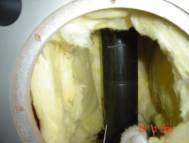 The sub is a downward firing, rear-ported design with an 8 inch cone driver and video
shielding.
The driver is custom manufactured using a polymer treated paper cone with a butyl
rubber surround and a polycotton spider.
When I asked Dr. Hsu about these design decisions, he
said this construction was selected to provide a long a reliable service life while maintaining cost;
and that he has not found significant advantage
in using drivers made of exotic materials.
The amplifier is a high current BASH (Bridged Amplifier Switching Hybrid) a proprietary amplifier
design licensed from a company called Indigo,
http://www.bashaudio.com/technologies.htm
, that
attempts to find a compromise between class A/B amplifier fidelity and class D amplifier
efficiency.
The STF-1 is rated at 150 watts RMS and has 600 watts of dynamic power.
The sub is a downward firing, rear-ported design with an 8 inch cone driver and video
shielding.
The driver is custom manufactured using a polymer treated paper cone with a butyl
rubber surround and a polycotton spider.
When I asked Dr. Hsu about these design decisions, he
said this construction was selected to provide a long a reliable service life while maintaining cost;
and that he has not found significant advantage
in using drivers made of exotic materials.
The amplifier is a high current BASH (Bridged Amplifier Switching Hybrid) a proprietary amplifier
design licensed from a company called Indigo,
http://www.bashaudio.com/technologies.htm
, that
attempts to find a compromise between class A/B amplifier fidelity and class D amplifier
efficiency.
The STF-1 is rated at 150 watts RMS and has 600 watts of dynamic power.
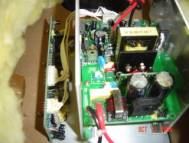 The amplifier, along with all the controls and connections, are mounted on the back face
of the unit.
The sub has a three-way power switch with off/auto/on settings, a two-way phase
switch with 0 deg/180 deg settings, and a crossover bypass switch.
There are continuously
variable knobs provided for volume settings and crossover frequency that can be varied from 30 to 90 Hz
using a 24 dB/octave Linkwitz-Riley low pass filter.
Connection to the sub can be made at line
level through a single RCA type line-in or at speaker level with binding posts that include
speaker in/out connections.
The back
panel also accepts a detachable power cable and access to the main fuse.
The amplifier, along with all the controls and connections, are mounted on the back face
of the unit.
The sub has a three-way power switch with off/auto/on settings, a two-way phase
switch with 0 deg/180 deg settings, and a crossover bypass switch.
There are continuously
variable knobs provided for volume settings and crossover frequency that can be varied from 30 to 90 Hz
using a 24 dB/octave Linkwitz-Riley low pass filter.
Connection to the sub can be made at line
level through a single RCA type line-in or at speaker level with binding posts that include
speaker in/out connections.
The back
panel also accepts a detachable power cable and access to the main fuse.
Inside the STF-1, the cabinet is damped with fiberglass-based material. After removing the woofer, I attempted to remove the plate amplifier, which is mounted with ten wood screws to the cabinet, only to find that it was still securely affixed to the unit. The amplifier section is mounted to the back plate on metal fins secured with additional screws.
STF-1 Setup & Listening Tests
I listened in both the context of a home theater application and in a stereo application.
For audio/video listening, the sub was located were I normally place my own sub, the front right corner of room. Dr. Hsu made some recommendations for possible listening positions that also included along side the couch, near the center of the room. I tried this location but found it unsuitable; the couch muffed the sub, distorting the sound at the listening position. Connection to the STF-1 was made using a dedicated Sub-out channel. After connecting, I listened to the phase response and found the 0 deg setting to be appropriate. The crossover was set to 80 Hz at the receiver.
During stereo listening, the sub was connected to a second preamplifier output channel and mated with monitor speakers I usually have in my home theater system. The unit was placed in the left front corner, to the side of the left speaker. I again found that 0 deg phase was reinforcing and after some listening around the specified roll off point for the main speakers, I went with a subwoofer cross over frequency of 60 Hz. I heard excessive audible overlap with the crossover set at 65 Hz or higher.
I listened with the intent to consider what Dr. Hsu has said are aims in his design of the STF-1. While considering the cost of the unit, I listened for the obvious, such as extension and output, but more importantly, I listened for how musical the sub sounded and how well it blended in with the rest of the system. I personally do not believe in the concept of speaker designs for movies versus music; I find it tends to be used as an excuse applied to equipment that does not sound very good, but has flaws that pander to the sensationalized presentation inherent in movie sound effects. Well designed equipment should not sacrifice sonic accuracy to make explosions seem louder than the equipment has ability to play.
Ported designs are more efficient, making the most out of what amplified power is available, but they are more difficult to tune. Using a port makes the sub more sensitive to resonant frequencies that, if not properly executed, can ruin reproduction quality. Too many manufacturers of mediocre products aim for the obvious, and loud is obvious. When an inexpensive sub is combined with loud as a primary goal, loud is all there is, and the method by which loud is achieved in budget usually requires the shortcomings that cause a sub to be "boomy" with one note tuning sound characteristics. It is my opinion that if a sub sticks out and cannot act as an extension of the system of which it is part, then it is a poor design.
To this end, listening selections were geared to revealing the musicality of this subwoofer system, as well as verifying that it was capable in the more obvious expected areas. Can the sub retain musical timbre while kicking out explosions; can it keep up with a moving bass line without tripping over itself, can it capture dynamics while maintaining composure?
Listening Tests
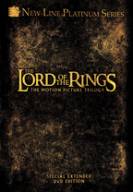 The Lord of the Rings: The Fellowship of the Ring
(
Extended
Edition)
The Lord of the Rings: The Fellowship of the Ring
(
Extended
Edition)
This
selection was made for a number of reasons.
The well-written score makes use of the LFE channel
for music and a good sub will add to the depth of the brass, strings, and percussion, framing out the
sound without being otherwise obtrusive.
Of the three movies, I personally find the fidelity of
the first movie superior; the sound is fuller with greater clarity and openness.
That the sound
effects are also spectacular is obvious, but I will mention it for completeness' sake.
The STF-1 blended in musically, adding depth to the score within the limits of its extension. There are subs that can do more, but there is cost associated to buy that additional frequency response and output. Within the STF-1's frequency capabilities, the instruments were rich and retained their timbre. Standout scenes for display of the subs musicality in presenting low strings, brass, and percussion included "Buckle-berry Ferry", "Weathertop", "Flight to the Ford", "Lurker in the Waters", "Drums in the Deep", and "The Bridge of Khazad-dum". The STF-1 did its job, reinforcing the score without drawing due attention to itself until called for by the sound effects.
And, when called for, the sub would speak up and make its presence known. Even with a stated lower frequency response of 30 Hz, the STF-1 could convincingly rumble the room. I did not find the STF-1 as tight as I am used to, but the STF-1 did well to minimize shortcomings associated with some inexpensive ported designs. Dynamics were good, but under some of the most demanding sound effects, I did hear what sounded like possible port noise. I will state that I did not observe this for any other source material or listening conditions.
I also did notice some tendency towards resonant excitation, but again, only with this soundtrack. Movie soundtracks are aimed towards the sensational, not necessarily the realistic. Movie sound effects are described at www.Filmsound.org as hyper-real, meaning that they are deliberately exaggerated, and many effects are cobbled together from various unrelated sounds that can be modified to give a particular illusion. Subwoofers, in particular, are often challenged to recreate these exaggerated sounds, leaving only the finest able to overcome what these demanding sounds require without exposing their design shortcomings.
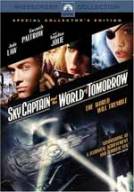 Sky Captain and the World of Tomorrow
Sky Captain and the World of Tomorrow
This is the
kind of movie to keep any sub busy.
With all of the airplanes, gunfire, explosions, and
earthshaking giant robots, the STF-1 maintained composure and delivered rumble without sacrificing the
score.
At realistic listening levels, the sub delivered while appearing to not strain its
headroom limits.
Plane engines had realistic depth, explosions were dynamic, and I could actually hear the inner harmonics present in the approaching footsteps of the giant robots that invade Manhattan. The scene at the end where Sir Laurence Olivier gives a speech, as Dr. Totenkopf, through an electrical discharge display, resonated satisfyingly as the image repeatedly broke up and reformed.
I did catch the sub making a popping noise, once, during the final scene on the rocket when the emergency release was activated and the final cargo sections were dropping from the hull. To put this in context, I did not notice it the first time I watched this movie with the goal of seeing how well the sub blended into my system, but on a subsequent viewing with the sub turned up, a little disproportionately, while trying to hear what exactly the sub was contributing.
 Porcupine Tree:
Deadwing
(DVD Audio)
Porcupine Tree:
Deadwing
(DVD Audio)
I was glad to see this
album receive a favorable
review
on
this site recently.
I personally like this band, and I am pleased to see these musicians get a
little recognition.
It is also a good test for subwoofers as advertised.
There is a lot
going on at the low end and it all moves along quickly.
A sloppy sub with poor transient response
will be left behind.
There are elaborate drum parts, and exposed bass lines abound. The STF-1 performed what was asked of it. It kept up with double bass drum parts while blending into the system. The bass was solid but was not "boomy". "Halo" is a prime example, the exposed bass part was full, and staccato bursts of bass drum did not cause any loss of control.
The sub handled dynamic changes well. During "Arriving Somewhere but Not Here", when the last verse instantly starts up, the sub sounded as if it had been playing along the whole time. Less physically demanding, but subtler musical sections were handled well also. The inner detail of the articulate bass line in "Glass Arm Shattering" came through well.
At times, the STF-1 was able to convince me that the extension was deeper than I expected, and at other times, I could hear something missing. The bass drum part in "Mellotron Scratch" was unusually deep, and about sixteen measures into "Arriving Somewhere but Not Here", the bass came in, and held for a number of measures, and the STF-1 allowed the note to rumble away. But during the opening of "The Start of Something Beautiful", the depth of the synthesizer part was a little lighter than it should have been. On the other hand, the sub was able to sonically separate the intertwined bass guitar and low synthesizer parts from each other and resolve inner detail in those parts.
STF-1 Listening Tests & Conclusion
Yes:
Talk
 This recording has some demanding, sudden dynamics in the bass, so
it made sense to me to give it a spin.
The bass is deep and the sonic character of the recording
sounds a bit like actually being at a concert.
This recording has some demanding, sudden dynamics in the bass, so
it made sense to me to give it a spin.
The bass is deep and the sonic character of the recording
sounds a bit like actually being at a concert.
Throughout the album, bass lines were full and well blended with the main speakers. Tonal character at the low end was musical. A good example is the timpani part during "Where Will You Be" where timbre was adequately retained. The standout dynamic transitions occur during "I Am Waiting" where the whole band kicks in towards the end, and the opening movement of "Endless Dream: Silent Spring". The STF-1 handled both well, maintaining composure.
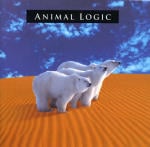 Animal Logic II
Animal Logic II
Animal Logic was a short-lived ensemble that put out a
couple of albums in the early 90's.
Stewart Copeland, formerly of The Police, and Stanley Clarke,
whose resume includes
Return to Forever
with Chick Corea, support a singer by the name of
Deborah Holland.
Various studio musicians round out the rest of the instrumentation.
On
this album, Stanley Clarke is featured, effectively playing the electric bass as a lead instrument,
carrying the melody for most of the album.
The STF-1 kept up with Clarke's tightly played, moving bass lines throughout this album as well as Copeland's syncopated drum parts. The subwoofer's extension was adequately deep to fill out the sound and blended seamlessly with the main speakers in this more exposed sonic context. Stanley was able to move between lower and higher registers without noticeable dips, peaks, or phasing troubles.
Slapped bass lines, chords, and a whole lot of notes were thrown at the STF-1, which pulled it all off musically and managed to render inner details. "Stone In My Shoe" features a quickly moving bass solo that the STF-1 was able to keep up with. The final track, "What Looks Good on the Outside", is the only piece with acoustic bass and this gorgeous part was handled well by the sub.
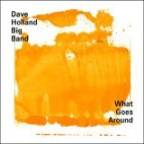 Dave Holland Big Band:
What Goes Around
Anyone who has heard Dave Holland play will know why this a good test for musicality for any bass
driver.
This guy can play.
The double bass lines in his performances just don't stop
moving.
With a big band around him, there is a lot for any speaker system to do.
Dave Holland Big Band:
What Goes Around
Anyone who has heard Dave Holland play will know why this a good test for musicality for any bass
driver.
This guy can play.
The double bass lines in his performances just don't stop
moving.
With a big band around him, there is a lot for any speaker system to do.
Uptempo pieces saw the STF-1 keep up; slower pieces had the required delicacy. Exposed bass lines were detailed and articulate and the low woodwinds and brass were filled in nicely. Most importantly, instrumental timbres in the lower register were maintained. During "Shadow Dance", the sub did well with a lot of articulated, staccato playing with vibrato, 1/4 and 1/2 step bends, and chords. Slow charts like "Blues for C.M." and "First Snow" were musical and detailed as required.
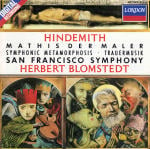 Hindemith:
Symphony 'Mathis Der Mahler' Trauermusik Symphonic
Metamorphosis
Hindemith:
Symphony 'Mathis Der Mahler' Trauermusik Symphonic
Metamorphosis
San Francisco Symphony, Herbert Blomstedt (London Records)
There's nothing like some twentieth century orchestral music for evaluating musicality of a bass driver, so I selected Hindemith. These compositions make substantial use of low strings and brass, with a full sound and good hall acoustics captured in this recording.
The STF-1 provided a musically satisfying performance of the low strings in these compositions. The bass output was deep, musical timbres of the instruments were retained, and the subwoofer supported and framed hall resonances in the recording. Of note, the bass drum in "Versuchung des heiligen Antonius" resonated with depth through the hall. The subwoofer did sound somewhat loose at times, but was not "boomy". A convincing recreation of the low frequency effects within an orchestra hall is a challenge for many subwoofers and the STF-1 fared well considering its price point.
Conclusions & Recommendations
Overall, my impression of the STF-1 is positive. The sub plays with satisfying output levels with the ability to vibrate the room it is in. In terms of design intent, the STF-1 succeeds. The appearance, while average and unremarkable, has a solid construction and good fit and finish. Usability and features were standard for the majority of subs. In another room with a different layout, the ability to slip the unit behind a couch or mid-way along a side wall may be more successful in evening out in-room bass response than my experience.
Sonically, the sub did its real job well. Listening, particularly with music as source material, revealed a well-tuned, ported design that was able to maximize its inherent design advantages, while minimizing the shortcomings of some less competently executed ported designs. The STF-1 represents a high level of performance for its price range. More importantly, the sub is able to fit well into different listening systems and provided a musical presentation of the source material. The STF-1 can keep up with fast pounding as well as more articulate and delicate program material. The sub's ability to maintain musical timbres and reveal inner detail was good. Considering the context of price, I'd have to say quite good.
The STF-1 made a good showing of itself by all accounts. Any shortcomings the STF-1 had were limited and would not be obvious except in direct comparisons or if one had spent a lot of time in the company of more expensive subs. There are subs that are tighter, deeper, more accurate, and even more musical, but they tend to cost more; some a lot more . For the price, this is a product definitely worth considering for an audition.
The Score Card
The scoring below is based on each piece of equipment doing the duty it is designed for. The numbers are weighed heavily with respect to the individual cost of each unit, thus giving a rating roughly equal to:
Performance × Price Factor/Value = Rating
Audioholics.com note: The ratings indicated below are based on subjective listening and objective testing of the product in question. The rating scale is based on performance/value ratio. If you notice better performing products in future reviews that have lower numbers in certain areas, be aware that the value factor is most likely the culprit. Other Audioholics reviewers may rate products solely based on performance, and each reviewer has his/her own system for ratings.
Audioholics Rating Scale




 — Excellent
— Excellent



 — Very Good
— Very Good


 — Good
— Good

 — Fair
— Fair
 — Poor
— Poor
| Metric | Rating |
|---|---|
| Bass Extension | |
| Bass Accuracy | |
| Build Quality | |
| Fit and Finish | |
| Ergonomics & Usability | |
| Features | |
| Performance | |
| Value |

